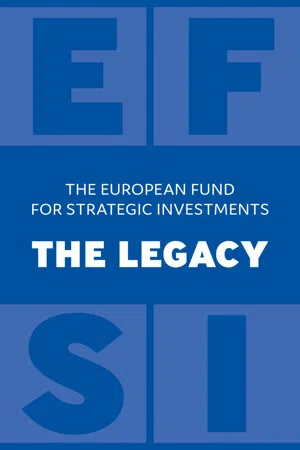![]()
Chapter 1
What is it?
The financial arm of the Investment Plan for Europe, the European Fund for Strategic Investments, tackles three pressing issues–economic, environmental and non-financial barriers to investment, capacity constraints and subdued investment activity. The plan was designed by the European Commission and the European Investment Bank in 2014 and launched for a five-year period in the summer of 2015.
It was born from the diagnosis that following the 2008 financial and economic crisis, investment activity in Europe was far too low and that the competitiveness gap between Europe and other parts of the world was growing rapidly. These problems were driven by a credit crunch for private sector financing (despite ample liquidity), a fragmented banking system, underdeveloped capital markets and severely limited public resources, as well as other non-financial investment barriers.
As the financing arm of the Investment Plan for Europe, EFSI enables and challenges the European Investment Bank Group to increase support for viable projects with risk profiles that go beyond the EIB’s own risk-bearing capacity. As a public policy instrument, it also has to address market failures and suboptimal investment situations.
From the beginning, EFSI had three clear objectives: additionality, mobilised capital and impact. The eligibility of each project for the EFSI guarantee is assessed based on these three criteria. The EIB Group remains the lender or financier, with all related activities performed by the EIB (such as due diligence, funding, risk management, legal and contractual requirements towards the client, monitoring, governance, etc.). That allows EFSI governance (as the guarantor) to focus solely on the crucial decision as to whether the EU guarantee should be made available, based on the assessment of the EFSI eligibility criteria. This keeps the process lean and efficient.
The EIB Group has a detailed reporting obligation towards the European Commission (which provides the guarantee) and the European Parliament (which legislates the EFSI regulation).
Wilhelm Molterer, Managing Director
Here’s how I would describe EFSI to someone who knew nothing about it. You have two big machines. One is called the EIB Group. The other is the EU budget. As long as the two machines are running in parallel and not interconnected, their efficiency is no more than acceptable. But if you put the strength of these machines together, you are not just doubling the effort—you are making three to five times more out of what you put in. EFSI has an even higher level of multiplication. If you have a budget guarantee of €1, you make €15 in terms of the investment volume supported in the real economy. That is the real story.
When EFSI started, the problem was not liquidity. The European Central Bank did a great job of stabilising the markets, and the banks had liquidity. The issue was their limited risk-bearing capacity. If you really wanted to restart the economy in the European Union, you had to take on some of the risk to enable both the public and the private sector to invest again. Call it a type of insurance that we offered at that time, focusing not only on economic stabilisation, but also on a return to growth-enhancing investment. This was the real key: we had to do what the markets needed, which was not to provide liquidity, but to bear some of the risk. This was also why new products were deployed relatively quickly. Risk-sharing instruments were not available at the EIB before, at least not to the same extent. Quasi-equity [also known as venture debt], providing the capacity to support innovative and fast-growing companies, did not exist at the Bank before EFSI. The EIF had the scope to do substantially more, because the guarantee gave it more firepower, whereas at the EIB it was about doing things differently. It was all about higher risk-taking and being additional. That was the fundamental story.
The second surprising thing was that originally, we all thought the main users of EFSI financing would come from the public sector, but this turned out not to be true. The private sector came to us and said, “We want to be the first movers in this.” At first, it seemed that companies supported by an EFSI loan from the EIB might be perceived as rather risky. But within months, it turned out to be the other way around. Companies realised that the markets reacted totally differently, saying, “if you have an EIB loan with an EFSI guarantee, you are more innovative. You are an interesting company, a company that looks forwards and not backwards.” This was a clear indication that we were on the right track. What we ultimately did was show that there was demand in the market.
There had not really been anything like EFSI before. InnovFin provided some guidance about where we wanted to go because it mixed financial instruments with the EU budget. But it was very narrowly focused. EFSI is much broader and supports real needs in the market. First and foremost, small and medium-sized enterprises (SMEs): in some countries, we had a real credit crunch at the time and SMEs had no access to financial products. The second thing was innovation, research and development. The third was infrastructure—in some regions of the European Union, this is still a critical part of making the economy stronger. And last but not least, the climate and the environment.
Iliyana Tsanova, Deputy Managing Director
I would point out four aspects that make EFSI unique and define its legacy. It was the first, highly visible flagship initiative of the European Commission on such a large scale and with such an impact. EFSI was a real pan-European response to a massive economic and social challenge the European Union was facing at the time. The second point is that EFSI revolutionised how public funding can be used as an instrument to mobilise capital and catalyse investment, instead of one-off grants, and this philosophy is here to stay. Third, EFSI clearly demonstrated that an economic recovery package can be fully in line with sustainability objectives. Lastly, EFSI was deployed very quickly in the real economy without unnecessary bureaucracy, thanks to its efficient governance, simple management rules and the clear objectives set in the legislation.
Car battery tech charges ahead
With electric vehicle production rising rapidly, manufacturers from all over the world rely mostly on batteries imported from South Korea, China or Japan. With an important collaboration deal with Volkswagen and BMW under its belt, Northvolt is confident that Europe is changing the current state of play. The Swedish company has built one of the world’s most advanced battery factories. “Renewable energy storage is the key to a carbon-neutral society,” says Peter Carlsson, the former Tesla executive who heads Northvolt, “and batteries are the key to getting there.”
Backed by the EFSI guarantee and the EU’s InnovFin programme, the European Investment Bank supported Northvolt’s construction of a concept demonstration line in Västerås, not far from Stockholm. The factory started producing its new battery at the end of 2019, but by then Northvolt was already looking much further ahead. The next step is a lithium-ion battery factory in Skellefteå, northeast Sweden, which will employ up to 1 400 people and serve as a stepping stone to producing batteries with a capacity of 32 gigawatt-hours by 2023. The company aims to ramp up even further to 40 gigawatt-hours in subsequent years. The Skellefteå factory will be backed by another European Investment Bank loan, this time for €400 million, again using the EFSI guarantee.
“I’m trying to show Europe that carbon-free energy can be stored better, distributed with higher quality and lower costs and made more sustainable and truly available,” Carlsson says. “I want to inspire change and flick a switch for Europe.”
Inside EFSI:
The Deputy Managing Director
In 2015, Iliyana Tsanova was in charge of EU co-financing and financial engineering with the European Bank for Reconstruction and Development (EBRD) in London. She had been following the development of EFSI closely and was already trying to set up a partnership with the EIB under EFSI. In July that year, a colleague forwarded her a link to a job vacancy. The post was the Deputy Managing Director of EFSI. Tsanova, who was 39 at the time but had already served as Deputy Prime Minister of Bulgaria in a technocratic caretaker government, immediately liked the idea. “I knew I was a strong candidate for the job and I could add value,” she recalls. “I have the experience, both in banking and policy. From my work with the EBRD, I really know something about finance additionality.” Late that night, she pressed “Send” on her application and began a journey that would take her to confirmation hearings at the European Parliament and conferences across Europe, telling the story of EFSI.
By October, she was preparing for the public hearing at the European Parliament in Brussels. That’s when she first met Wilhelm Molterer. The day before the hearings, they talked about their roles in Luxembourg and travelled by car to the Belgian capital for “by far the most difficult job interview I have ever had,” she remembers, laughing. “I was sitting in front of 100 members of the two responsible committees of the Parliament and I didn’t have a clue about the questions I would be asked. It was a very open and genuine discussion, which I really enjoyed after my initial couple of minutes of stress passed.”
The working relationship that developed between the Managing Director and Deputy Managing Director of EFSI became key to the smooth functioning of the programme. “We are a small team,” Tsanova says. “Having good chemistry among the members of the team really matters. If we didn’t have that it would have been very difficult for us to function well. I appreciate Willi’s great personality and I’ve learned a lot from his experience as a politician and as a member of the management team of the EIB. We were initially put together in a sort of arranged marriage. And it actually worked out pretty nicely.”
Iliyana is a strong personality. It’s great to work with her. She aims very high and sets extremely high standards for whatever she does. She has also brought in something new because she comes from the EBRD, another international financial institution, but with a totally different ...





